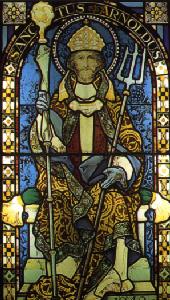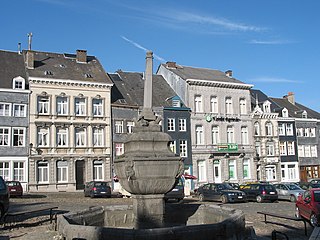Related Research Articles

Amandus, commonly called Saint Amand, was a bishop of Tongeren-Maastricht and one of the great Christian missionaries of Flanders. He is venerated as a saint, particularly in France and Belgium.

Arnold (Arnoul) of Soissons or Arnold or Arnulf of Oudenburg is a saint of the Roman Catholic Church, the patron saint of hop-pickers and Belgian brewers.

Saint Maurus, O.S.B., was the first disciple of Saint Benedict of Nursia (512–584). He is mentioned in Saint Gregory the Great's biography of the latter as the first oblate; offered to the monastery by his noble Roman parents as a young boy to be brought up in the monastic life.
Saint Abram was a contemporary Coptic Orthodox saint. He was the Bishop of Faiyum and Giza, and was also known as the Friend of the Poor.
Saint Finnian of Clonard – also Finian, Fionán or Fionnán in Irish; or Vennianus and Vinniaus in its Latinised form (470–549) – was one of the early Irish monastic saints, who founded Clonard Abbey in modern-day County Meath. The Twelve Apostles of Ireland studied under him. Saint Finnian of Clonard is considered one of the fathers of Irish monasticism.
Saint Amatus, also called St. Aimé, was a Benedictine monk.

The Roman Catholic Diocese of Orléans is a diocese of the Latin Rite of the Roman Catholic Church in France. The diocese currently corresponds to the Départment of Loiret. The current bishop is Jacques André Blaquart, who was appointed in 2010.

Saint Felix of Valois was a hermit and a co-founder of the Trinitarian Order.

The Roman Catholic Diocese of Saint-Flour is a Diocese of the Latin Rite of the Roman Catholic Church in France. The diocese comprises the department of Cantal. Erected in 1317, the diocese was suffragan of the Archdiocese of Bourges until 2002. With the general reorganization of the structure of the French church by Pope John Paul II, Saint-Flour became the suffragan of the Archdiocese of Clermont. The seat of the bishop is located in Saint-Flour, Cantal.

Saint Remaclus was a Benedictine missionary bishop. He grew up at the Aquitanian ducal court and studied under Sulpitius the Pious, bishop of Bourges. Remaclus became a monk in 625 and was then ordained a priest. He was the first to head the monastery of Solignac after being appointed by Saint Eligius.

Rodulf was the archbishop of Bourges from 840 until his death. He is remembered as a skillful diplomat and a proponent of ecclesiastical reform. As a saint, his feast has been celebrated on 21 June.

Fontgombault Abbey, otherwise the Abbey of Notre-Dame, Fontgombault, is a Benedictine monastery of the Solesmes Congregation located in Fontgombault in the département of Indre, in the province of Berry, France. It was built in the Romanesque architectural style. The monastery, founded in 1091, was dissolved in 1791 and refounded in 1948.
Saint Faro, Count of Guines, was bishop of Meaux. The family to which Faro belonged is known as the Faronids and is named after him.
Saint Eustace of Luxeuil, also known as Eustasius, was the second abbot of Luxeuil from 611. He succeeded his teacher Saint Columbanus, to whom he had been a favourite disciple and monk. He had been the head of the monastic school.

The Roman Catholic Archdiocese of Clermont is an Archdiocese of the Latin Rite of the Roman Catholic Church in France. The diocese comprises the department of Puy-de-Dôme, in the Region of Auvergne. The Archbishop's seat is Clermont-Ferrand Cathedral. Throughout its history Clermont was the senior suffragan of the Archdiocese of Bourges. It became a metropolitan see itself, however, in 2002. The current Archbishop is François Kalist.

Saint-Cyran-du-Jambot is a commune in the Indre department in central France.

Maurontius of Douai was a nobleman and Benedictine abbot. His parents were Rictrude and Adalbard. He is a Catholic saint, with a feast day on May 5, especially venerated in Douai, France. His sisters Clotsinda, Adalsinda and Eusebia of Douai are also saints.
Barontius (Barontus) and Desiderius were two 8th century hermits who are venerated as saints by the Catholic Church. They were hermits near Pistoia, in Italy.

December 4 - Eastern Orthodox liturgical calendar - December 6

The Abbey of Saint-Cyran-en-Brenne, also known since 1975 as the Abbey of Saint-Michel-en-Brenne, is an abbey in the town of Saint-Michel-en-Brenne in France, previously in the province of Berry and now in the department of Indre.
References
- ↑ "Den hellige Sigiramnus ( - ~655)". Katolsk. n.d. Retrieved May 18, 2009.
- 1 2 3 4 5 6 7 Alban Butler, The Lives of the Fathers, Martyrs, and Other Principal Saints (Published by Duffy, 1845), 71.
- 1 2 3 4 5 6 7 8 Alban Butler, Kathleen Jones, David Hugh Farmer, Paul Burns, Butler's lives of the saints (Published by Liturgical Press, 2000), 41-2.
- ↑ "Sigirannus, S. (1)". Zeno.org. n.d. Retrieved May 17, 2009.